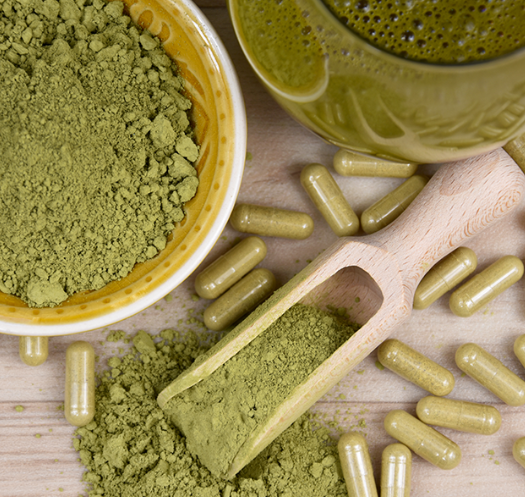“Kratom” refers to both Mitragyna speciosa, a tree native to Southeast Asia, and to products derived from its leaves that are marketed as herbal supplements. Kratom leaves contain many chemical compounds (known as bioactive alkaloids) that can affect the body. The most well-studied compounds related to kratom are mitragynine and 7-hydroxymitragynine.
Much is still unknown about chemical compounds related to kratom, the short- and long-term health and safety impacts of kratom use and kratom’s potential therapeutic uses. NIDA supports and conducts research on kratom and related chemical compounds to help inform kratom policy and health decision-making around kratom use.
While kratom or its related compounds have not been approved by the U.S. Food and Drug Administration as safe and effective for any medical use, people report using kratom products to alleviate drug withdrawal symptoms and cravings (particularly for opioids), to alleviate pain and to help manage mental health problems. NIDA is particularly interested in studying how kratom use may impact opioid use, which continues to drive the drug overdose epidemic in the United States.
People typically use kratom by swallowing raw plant matter in capsule or powder form, mixing kratom powder into food or drinks, brewing the leaves as a tea, or taking liquid kratom extract. People who use kratom report both stimulant-like effects (increased energy, alertness and rapid heart rate) and effects that are similar to opioids and sedatives (relaxation, pain relief and confusion). Studies and case reports have also indicated rare adverse effects may be associated with kratom or individual kratom compounds.
Anthropologists report that kratom has been used in Southeast Asia for hundreds of years as a multi-purpose remedy in traditional medicine, to increase alertness and energy while working and during social gatherings. While estimates of the scope of kratom use in the United States vary,19 the expansion of kratom vendors and increasing case reports suggest kratom use has become more common over the past two decades.

Kratom for opioid withdrawal: Does it work?
Kratom is promoted as a treatment to ease withdrawal symptoms from opioid medicines. But it can cause addiction and withdrawal symptoms of its own.
If you take pain medicines such as oxycodone (OxyContin, Roxicodone, others) for a long time, your body becomes used to these drugs and you may become dependent on them. As a result, you may have unpleasant physical symptoms when you stop taking these medicines, especially if you stop suddenly. These symptoms include sweating, vomiting, fever, agitation and anxiety. You also may feel like you have the flu. These symptoms are part of a process called withdrawal. It may last for several days to weeks.
Because withdrawal is often not pleasant, many people look for ways to ease the symptoms. Some people take medicines or substances to try to ease their symptoms. One of these substances is kratom.
Researchers have studied kratom as a potential treatment to ease withdrawal symptoms. But evidence suggests that rather than treating addiction and symptoms of withdrawal, the use of kratom may lead to addiction and withdrawal symptoms. Commercially available kratom products are not “natural.” They often have high levels of very addictive substances. And kratom may contain dangerous contaminants, including heavy metals and harmful bacteria.
Over time, people who use kratom may get cravings for it and need the same medicines used to treat opioid addiction, now called opioid use disorder. These medicines include buprenorphine (Brixadi, Sublocade) and buprenorphine-naloxone (Suboxone, Zubsolv). When kratom is used during pregnancy, the infant may have symptoms of withdrawal after birth.
As with pain medicines and recreational drugs, it is possible to overdose on kratom. But this is rare. The treatment for kratom overdose is like the treatment for opioid overdose. This includes the use of naloxone (Narcan, Kloxxado, others) and getting medical attention right away.
Although people may enjoy the good feelings that kratom can produce, kratom hasn’t proved to be an effective treatment for opioid withdrawal. And a small number of people — small compared to deaths from other drugs — have died after taking kratom.
